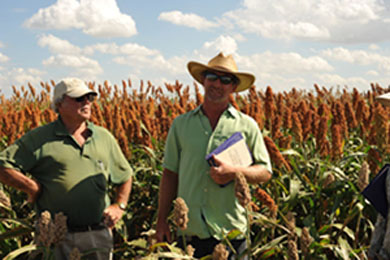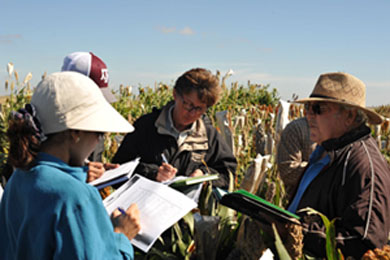5585 Guilford Road • Madison, WI 53711-5801 • 608-273-8080 • Fax 608-273-2021
www.agronomy.org
Twitter | Facebook
NEWS RELEASE
Contact: Hanna Jeske, Associate Director of Marketing and Brand Strategy, 608-268-3972, hjeske@sciencesocieties.org
Sorghum: not so ho-hum
Mar. 16, 2016 - It’s an ancient grain that has been cultivated for thousands of years. Yet you may not even have heard of it.
Sorghum was first grown more than 6,000 years ago in northeastern Africa. Many varieties of this drought-resistant, hardy crop are cultivated in other tropical and temperate areas, including India, China, and Australia. Farmers in the southern plains of the United States have been growing this hardy cereal since the1800s.
 Researchers recently released 40 varieties of early-flowering sorghum bred for use in cooler, more temperate areas. These early-flowering varieties of sorghum are critical for the spread of the crop to more new locations. When planted in areas with long days and cold soils, typical sorghum crops face difficulties.
Researchers recently released 40 varieties of early-flowering sorghum bred for use in cooler, more temperate areas. These early-flowering varieties of sorghum are critical for the spread of the crop to more new locations. When planted in areas with long days and cold soils, typical sorghum crops face difficulties.
“Sorghum originates in the tropical areas of Africa—it does not like cool temperatures or the long days in temperate climates,” says Robert Klein. Klein is a researcher at the USDA-ARS and Texas A&M University.
As seasons change, the length of the day varies much more in temperate areas than in tropical regions. Sorghum needs day lengths of less than 12 hours and 20 minutes to flower. However, by the time days become short enough in late summer for sorghum crops to flower, it also becomes too cold for them to survive in temperate climates.
Researchers have one major advantage. “There is a great deal of naturally-occurring genetic diversity in the sorghum collection, and our research program exists to provide that genetic diversity to seed companies and eventually to the consumer,” says Klein.
The genetic diversity of sorghum—and other plants—is often preserved in germplasm collections. Researchers define ‘germplasm’ as a living genetic resource such as seed or tissue. “It is maintained for the purpose of animal or plant breeding. For plants that could be seeds, roots, tubers, cuttings from trees, or even collections of entire plants,” says Klein.
This genetic diversity is key. Diseases or pests can spread from one region to another and destroy entire crops. To prevent this, researchers can search germplasm collections and breed crop varieties with natural resistance.
“Germplasm collections allow us to guard against problems that we can't even anticipate while also preserving this genetic diversity for future societies. Once this biodiversity in these collections is lost, it cannot be brought back,” says Klein.
 Sorghum has many benefits for farmers, consumers, and the environment. It is a drought-tolerant crop. In many areas, it needs significantly less water than rice and corn. With fresh water becoming more limited for agriculture, crops such as sorghum may become more attractive to farmers. Sorghum has also been bred for a reduced need for herbicides and pesticides.
Sorghum has many benefits for farmers, consumers, and the environment. It is a drought-tolerant crop. In many areas, it needs significantly less water than rice and corn. With fresh water becoming more limited for agriculture, crops such as sorghum may become more attractive to farmers. Sorghum has also been bred for a reduced need for herbicides and pesticides.
In addition, sorghum has several nutritional benefits: It is a gluten-free grain. It has a low glycemic index, which makes it well-suited for those who need to maintain blood sugar balance. Certain varieties of sorghum have three to seven times the levels of antioxidants found in blueberries or strawberries. It is low in cholesterol and high in fiber. Sorghum has also been linked with good digestive and cardiovascular health.
Some varieties of sorghum are used as livestock feed. These have protein content and quality comparable to more traditional protein sources, such as soybeans. They also contain high levels of micronutrients, such as zinc, iron and phosphorus.
Read more about the newly-released collection of sorghum in Journal of Plant Registrations.
Journal of Plant Registrations is the official registration publication of the Crop Science Society of America. JPR publishes cultivar, germplasm, parental line, genetic stock, and mapping population registrations, as well as articles characterizing accessions held within plant germplasm collection systems and descriptions of plant genetic materials.